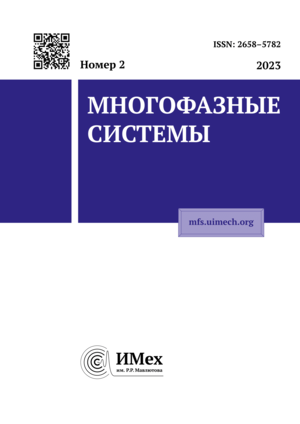

A one-dimensional time-fractional integral model for a two-phase flow through a porous medium with power-law memory in the presence of capillary forces is considered. Based on the time-fractional integral generalization of Darcy’s law and the classical mass balance equations for phases, neglecting gravity forces, a time-fractional integral generalization of the Rapoport–Leas equation is derived. It is shown that in the limiting case of constant capillary pressure, the obtained equation coincides with the classical Buckley–Leverett equation. An example of initial boundary value problem for the derived fractional integral equation is given for the case of a finite reservoir. Unlike the classical Rapoport–Leas equation, its time-fractional integral analogue does not have a traveling wave solution in general case. It is due to the fact that the fractional integral with a finite lower limit is not invariant with respect to translations in time. However, for the model problem of two-phase displacement in an unbounded reservoir, considered as a discontinuity breakup problem, the full memory approximation is valid. In this case the obtained equation has a traveling wave solution. In this approximation, relations for the main characteristics of the saturation jump on the shock are obtained. In particular, it is shown that the speed of the shock can be found from an equation that includes the time-fractional integral characteristic of the Leverett function. The behavior of the shock near its left and right boundaries is also asymptotically studied for different saturation levels at the boundaries. It has been proven that if the initial saturation exceeds the residual saturation of the displacing phase, then on the right boundary the saturation at the jump exponentially tends to the initial one. On the left boundary, the asymptotic behavior of the jump is also exponential, with the exception of one special case in which it becomes a fractional power law. For the equation in question, an approximate solution has been analytically constructed for the case of «weak» full memory, when the order of fractional integration is close to zero and can be considered as a small parameter.
two-phase flow in porous media,
capillary forces,
fractional integral,
fractional-order integral Darcy’s law,
transient wave solution,
small parameter,
approximate solution
Introduction
Modeling of multiphase flows in heterogeneous complex porous media is an important problem for underground hydrodynamics. This problem has a great interest in oil and gas industry. Nevertheless, the complexity of a corresponding model is highly increased if the complex structure of a medium is taking into account, and the number of model’s parameters is increased in such case. Therefore, the models having a relatively small number of parameters but giving the opportunity to describe the processes with a desired accuracy are very interesting for practice. An important class of such models can be obtained by using the fractional calculus.
Purpose
It is necessary to construct and study a phenomenological mathematical model of two-phase flow in a porous medium with power-law memory under assumptions that capillary forces are significant and gravitational effects are negligible.
Methods and approaches
A fractional generalization of Darcy's law for phases with time-fractional integral operator of order is considered under assumption of neglecting gravitational forces. Based on this law, by using the classical mass balance equations for phases, a time-fractional integral analogue of the Rapoport-Leas equation is derived. A model problem of two-phase displacement in an unbounded reservoir is considered for the obtained equation as the discontinuity breakup problem. By using the asymptotical approach, the qualitative characteristics of the saturation jump on the shock in the vicinity of its boundaries are investigated under different boundary conditions. For the case of “weak” full memory, when the order of fractional integration is close to zero and can be considered as a small parameter, an approximate analytical solution of the equation in equations is constructed by using the methods of perturbation theory.
Results
It is obtained a time-fractional integral generalization of the Rapoport–Leas equation which gives the opportunity to describe two-phase flows in a porous medium with power-law memory and capillary forces. It is shown that for a model problem of two-phase displacement in an unbounded reservoir this equation possesses a traveling wave solution. This solution describes a main stable zone of the saturation jump. It has been proven that if the initial saturation exceeds the residual saturation of the displacing phase, then on the right boundary the saturation at the jump exponentially tends to the initial one. On the left boundary, the asymptotic behavior of the jump is also exponential, with the exception of one special case in which it becomes a fractional power law. For the equation in question, in the “weak” memory approximation, an approximate analytical solution of the traveling wave type has been constructed in quadratures.
